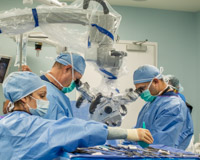October is off to a strong start for DISC Sports & Spine Center, as our expert surgeons have weighed in on a variety of health and wellness topics for stories in Everyday Health, WellnessPulse and Becker’s Hospital Review. At DISC, our world renowned specialists are happy to provide expert commentary as pioneers in their fields.
Here are a few of DISC’s most recent news features:
DISC’s Founding Director Shares Insights on Becker’s Hospital Review Podcast
Robert S. Bray, Jr., MD, CEO and Founding Director of DISC Sports & Spine Center, talked with Grace Lynn Keller for a live recording of the Becker’s Spine and Orthopedics Podcast at the Becker’s 22nd Annual Spine, Orthopedic and Pain Management-Driven ASC + The Future of Spine Conference.
LISTEN TO THE PODCAST:
Dr. Bray shared his insights on the accelerating shift toward outpatient spine care, the rise of global payment models, the role of AI across healthcare operations, and the importance of creating sustainable pathways for the next generation of surgeons.
“The biggest trend we’re seeing right now is that transition from hospital-based care to outpatient on a higher and higher acuity level – so things you would have never thought of being outpatient [...] – are all done routinely now at outpatient centers,” Dr. Bray said.
“The second is the transition of the payer model. I was raised in a fee for service, that changed. Then we moved through the value care options, and now we’re seeing a big migration to global payments. What’s happening is, as the ASCs (ambulatory surgery centers) can deliver a better product at a cheaper price break point, we can really move the needle. So we're going to global payment systems with our DISC model and we’re able to move that final product to the payer down a large number – sometimes 30, sometimes up to 50% less on the dollar spent.”

The third is that people are becoming aware of the need to look at cost efficiency and quality outcomes and link those two things together – not one in absence of the other, Dr. Bray told Becker’s.
“As we do that, the centers, payers and vendors are going to all need to get together to figure out if it’s producing a quality outcome, data driven, do we have a metric that it actually works, and then everyone needs to get on board,” he said. “That’s where we’re going to a good outcome, patient-centric at a good price break point.”
Dr. Raj Desai Weighs in on the 6-6-6 Challenge
The 6-6-6 walking challenge focuses on walking for 60 minutes three times per week, starting at 6 a.m. or 6 p.m Within the 60 minutes, the challenge suggests starting with six minutes of warm-up walking and end with six minutes of cool-down walking.
The 48 minutes in between should be done at a “brisk pace,” or zone 2, to elevate your heart rate and challenge your cardiovascular system, Raj Desai, MD, interventional pain and regenerative medicine physician at DISC Sports and Spine Center told Everyday Health.
 “I’m a firm believer in ‘movement is medicine,’” says Dr. Desai. “I strongly advocate for regular exercise and walking.”
“I’m a firm believer in ‘movement is medicine,’” says Dr. Desai. “I strongly advocate for regular exercise and walking.”
However, the 6-6-6 Challenge does have some drawbacks. Dr. Desai told Everyday Health that not everyone has an hour a day to walk, or the ability to exercise exactly at 6 a.m. or 6 p.m. — and he worries the strict guidelines could discourage people from exercising at all.
“The 60-minute daily commitment is significant, as many patients I work with struggle to get even 30 minutes in consistently,” he said.
The program also lacks personalization, with no consideration for fitness level, age, or overall health, he said. For those new to exercising, it could also cause injuries like shin splints or plantar fascilities.
At the end of the day, “The best exercise program is the one that you’ll actually stick with long term,” Dr. Desai said.
Dr. Chen Debunks the “Never Broken a Bone” Theory
Lots of theories online will make you side eye your screen, and the “never broken a bone” theory will do just that. The theory is that people who have never broken a bone are protected by spiritual energies or have endured enough emotional pain to compensate for the lack of physical injuries.
 Unsurprisingly, there’s no scientific evidence to support the theory. In fact, studies have linked experiencing hardship and mental health issues with poorer bone health.
Unsurprisingly, there’s no scientific evidence to support the theory. In fact, studies have linked experiencing hardship and mental health issues with poorer bone health.
There are many reasons why someone may be prone to breaking bones more frequently. James B. Chen, MD, orthopedic surgeon at DISC Sports & Spine Center, told WellnessPulse that bones aren't static structures that are just made of minerals.
“Rather, our bones are constantly remodeling, and bone quality can fluctuate throughout life. Optimal bone health occurs when there is balanced remodeling of a bone to tolerate stressors that may be placed upon it with an ideal amount of elasticity and rigidity,” he said.
If you’re more prone to injuries like fractures, there are some preventative measures you can take. Dr. Chen emphasizes the importance of following a well-balanced diet with adequate calcium and vitamin D intake. These nutrients are found in dairy, leafy greens, fish and other fortified foods. Exercise can help, too.
"Resistance exercise helps stimulate bone remodeling in response to the stress placed upon it. A popular trend right now is rucking or weighted-vest walking. This exercise can help reduce bone-density loss by increasing the stress on the bones," Dr. Chen told WellnessPulse.
Plus, those who have risk factors for osteoporosis or are 65 years and older may consider a DEXA scan to determine their current bone density, he said. While nutrition and exercise are often enough, individuals already diagnosed with osteoporosis may need bone-building medications.

About the author
discmdgroup DISC Sports & Spine Center (DISC) is a national leader in minimally invasive spine surgery, orthopedic surgery, and sports medicine care. Our spine surgeons set the standard in artificial disc replacement, spine fusion, discectomy, microdiscectomy and the full spectrum of spine procedures. The group’s orthopedic surgeons advance the state of joint preservation surgery and total joint replacement, including total knee replacement as well as total hip replacement. Our flagship surgery centers based in Newport Beach, Marina del Rey, and Carlsbad serve patients local to Los Angeles, Orange County and San Diego, as well as the rest of the country. Read more articles by discmdgroup.








